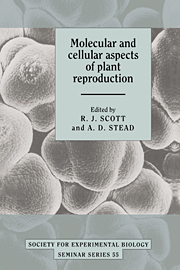Book contents
- Frontmatter
- Contents
- List of Contributors
- Introduction: ‘Where do we go from here?’
- Molecular control of floral organogenesis and plant reproduction in Petunia hybrida
- Control of floral morphogenesis in cauliflower (Brassica oleracea L. var. botrytis): the role of homeotic genes
- Isolation and properties of mutants of Arabidopsis thaliana with reduced sensitivity to short days
- Asexual mutants in Melandrium album (Silene alba): tools in cDNA cloning and analysis of an X/Y chromosome system in plants
- Pollen exine – the sporopollenin enigma and the physics of pattern
- The diversity and regulation of gene expression in the pathway of male gametophyte development
- Characterisation of Arabidopsis thaliana anther-specific gene which shares sequence similarity with β-1,3-glucanases
- Ovule cDNA clones of Petunia hybrida encoding proteins homologous to MAP and shaggy/zeste-white 3 protein kinases
- Towards the elucidation of the mechanisms of pollen tube inhibition during the self-incompatibility response in Papaver rhoeas
- Intracellular movement and pollen physiology: progress and prospects
- Organisation and functions of cell surface molecules on gametes of the brown algae Fucus
- Strategies of flower senescence – a review
- The physiology of petal senescence which is not initiated by ethylene
- Molecular biology of flower senescence in carnation
- Ethylene sensitivity and flower senescence
- Ethylene biosynthetic genes and inter-organ signalling during flower senescence
- Index
Molecular control of floral organogenesis and plant reproduction in Petunia hybrida
Published online by Cambridge University Press: 04 August 2010
- Frontmatter
- Contents
- List of Contributors
- Introduction: ‘Where do we go from here?’
- Molecular control of floral organogenesis and plant reproduction in Petunia hybrida
- Control of floral morphogenesis in cauliflower (Brassica oleracea L. var. botrytis): the role of homeotic genes
- Isolation and properties of mutants of Arabidopsis thaliana with reduced sensitivity to short days
- Asexual mutants in Melandrium album (Silene alba): tools in cDNA cloning and analysis of an X/Y chromosome system in plants
- Pollen exine – the sporopollenin enigma and the physics of pattern
- The diversity and regulation of gene expression in the pathway of male gametophyte development
- Characterisation of Arabidopsis thaliana anther-specific gene which shares sequence similarity with β-1,3-glucanases
- Ovule cDNA clones of Petunia hybrida encoding proteins homologous to MAP and shaggy/zeste-white 3 protein kinases
- Towards the elucidation of the mechanisms of pollen tube inhibition during the self-incompatibility response in Papaver rhoeas
- Intracellular movement and pollen physiology: progress and prospects
- Organisation and functions of cell surface molecules on gametes of the brown algae Fucus
- Strategies of flower senescence – a review
- The physiology of petal senescence which is not initiated by ethylene
- Molecular biology of flower senescence in carnation
- Ethylene sensitivity and flower senescence
- Ethylene biosynthetic genes and inter-organ signalling during flower senescence
- Index
Summary
Introduction
Flower development has intrigued man since the dawn of time. Firstly flowers are very attractive for their ornamental value and fragrance. Secondly, the flower forms the place in which the plants' reproductive organs and cells are formed. Therefore, development of efficient reproductive organs and cells is of vital interest for the maintenance of life on earth. For these reasons, flowers have also a considerable commercial value both in the area of the production of cut flowers and pot plants and in the area of plant breeding.
A typical dicot flower consists of four concentric whorls of floral organs. The outermost whorl contains the sepals. The main function of these floral organs is the protection of the vulnerable young flowerbud. The second whorl consists of the petals which are often very showy and serve an important function in the attraction of pollinators. Whorl three consists of the stamens in which the male gametes are formed. Whorl four consists of the carpels which are often fused to form a pistil. In the ovary of the pistil the egg cells are present within the ovules. Upon fertilisation, the pollen tube grows towards the ovules and the egg cells, and in a double fertilisation event the egg cell and the central cell are fertilised by the two male reproductive cells.
Floral induction, floral development and plant reproduction have been studied already for a long time especially at morphological and physiological levels.
- Type
- Chapter
- Information
- Molecular and Cellular Aspects of Plant Reproduction , pp. 9 - 16Publisher: Cambridge University PressPrint publication year: 1994
- 1
- Cited by



